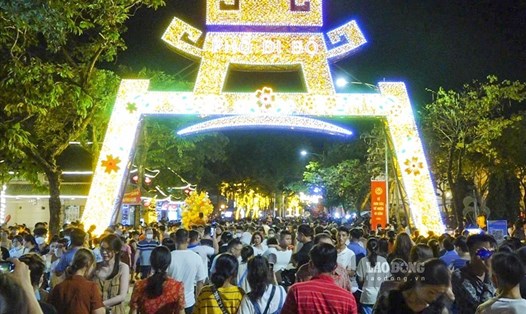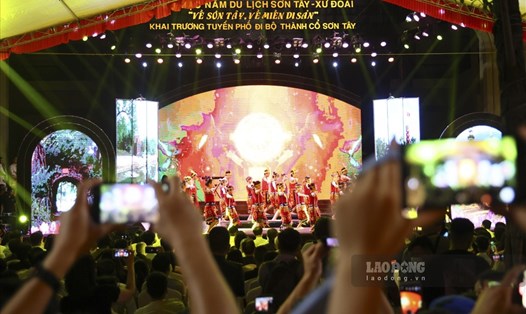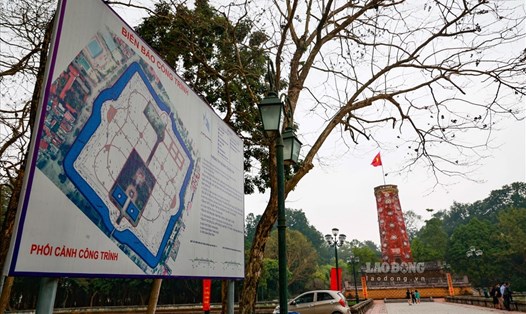Unique military architecture in the land of Xu Doai
Son Tay ancient citadel is now over 200 years old, marking the heroic history of the people of Doai region in fighting against foreign invaders. The citadel was built in the third year of Minh Mang (1822) with the most unique materials and architecture among the citadels in the country. Under the Nguyen Dynasty, this was the capital of the three provinces of Son Tay, Hung Hoa and Tuyen Quang, and was also the western defense agency of Thang Long citadel during battles.
According to the book “Dai Nam Nhat Thong Chi” which records the size and history of Son Tay ancient citadel, “Son Tay provincial citadel: 326 truong 2 thuoc in circumference, 1 truong 1 thuoc in height, 4 gates, moat 448 truong in circumference, 6 truong 7 thuoc in width, 1 truong in depth, located in the territory of Thuan Nghe and Mai Trai communes, La Pham commune, Tung Thien district... In the 3rd year of Minh Mang, it was moved to its current location and built with laterite. In the 2nd year of Tu Duc, the entire moat was built with laterite.”
Son Tay Citadel was built in the Vauban square architecture style, with a perimeter of up to 16 hectares, each side is up to 500m long, the wall is nearly 5m high and is built mainly of laterite. Surrounding Son Tay Citadel is a large moat, more than 20m wide, more than 2m deep, to go from the outside you have to go through bridges. The citadel has 4 gates opening in 4 directions: East, West, South, North, corresponding to the names of the Left Gate, the Right Gate, the Front Gate and the Back Gate. The citadel gates are quadrilateral in shape, trapezoidal in cross-section, with only one entrance and exit, inside each gate there are steps leading to the watchtower above. Outside is La Thanh, based on the natural terrain, with additional soil up to 3.5m high, pentagonal in shape and surrounded by bamboo hedges.
Old traces remain
Today, the remaining structures and ruins in the citadel include: Ky dai, Vong cung, Doan mon, Kinh Thien palace and well... The structures and architectures were built along the main axis of the citadel from South to North. According to the book "Kham dinh Dai Nam hoi dien su le" about some of the structures of Son Tay citadel: "In the citadel, there are the palaces of the Governor, Bo Chinh, An sat and De doc, each palace has 3 rooms and 2 wings. Only the Vong cung building was built with 5 rooms and 2 wings".
The first entrance through the South Gate is 2 quadrilateral wells built of laterite, up to 6m deep, which used to be the place to provide water for people living in the citadel. Passing through the 2 wells, it leads to the Son Tay citadel's flagpole, which is 18m high and consists of 3 parts: the base, the body and the roof. The base consists of 2 floors built in a quadrilateral shape, the upper floor is smaller than the lower floor, the base is built of laterite, and there is a railing running around the surface. Located in the center of the base is the body of the flagpole, built in an octagonal shape, with decorative air vents in the shape of asterisms and fan bands. Inside the flagpole, there is a spiral staircase leading to the top, standing from the top of the flagpole, you can observe the entire area inside and outside Son Tay citadel.

Continuing along the South - North axis, passing the flagpole leads to the Doan Mon of the ancient citadel. The Doan Mon was built in the "stacked match" style, including 3 doors, the main entrance in the middle is the widest, the side entrances on both sides are smaller. The Doan Mon is also the separating point, marking the outer area with the inner area, starting to step into the Kinh Thien Palace area. This is the most important point of the ancient Son Tay Citadel, the headquarters for the king to conduct meetings with officials when the royal procession is here. From the location of Kinh Thien Palace, looking to the East - West, are the mansions of officials, prisons, and old granaries.
In the mid-19th century, French colonialists attacked Vietnam, and in the 70s and 80s, French colonialists attacked Northern Vietnam. When the war broke out, Son Tay citadel became a center of defense and resistance against French colonialism by the Nguyen Dynasty's mandarins and soldiers, led by Hoang Ke Viem and Luu Vinh Phuc. In 1884, Son Tay citadel fell, and French colonialists occupied the citadel. However, in 1924, the colonial government in Indochina, the Governor-General of Indochina, issued a decree to rank Son Tay citadel as an ancient citadel.
Historical and cultural space of Xu Doai
Currently, Son Tay area in particular with a series of relics and scenic spots such as: Duong Lam ancient village, Mia pagoda, De Va, Son Tay ancient citadel is known as the green lung of Son Tay town center. Son Tay ancient citadel is currently one of the most attractive tourist destinations in Hanoi because of its historical and cultural space. Coming to Son Tay ancient citadel, visitors not only get to know historical stories and cultural beauties, but also have beautiful photo angles that cannot be found anywhere else.
Every season of the year, Son Tay ancient citadel seems to put on a new outfit with colorful vegetation. Especially since April 30, 2022, from the direction of Hanoi city, Son Tay ancient citadel walking street has been put into operation, the street is open on weekends. The walking street embraces half of Son Tay ancient citadel, stretching 820m, starting from Pho Duc Chinh street to the intersection of Quang Trung street (from the North gate to the West to the South gate). The walking street space opens up many sports, cultural, artistic and culinary activities. This has attracted about 10,000 - 15,000 visitors per week, transforming Son Tay ancient citadel from a historical and cultural center to today's expanded areas of art and cuisine.
Located about 45km from the center of Hanoi, visitors can travel by personal or public vehicles with convenient routes. Some bus routes 70 and 77 will take visitors to Son Tay ancient citadel. For young people who love to travel on short routes, this is also an extremely reasonable location, moving along Highway 32 to Son Tay town, from here continue moving to the center of the town to reach Son Tay ancient citadel.
With its historical, cultural values and unique architectural and artistic features, Son Tay ancient citadel is known by another name, "the citadel built of laterite". On October 15, 1994, the Ministry of Culture and Information (now the Ministry of Culture, Sports and Tourism) signed Decision No. 2754-QD/BT to rank Son Tay ancient citadel as a historical and cultural relic.









